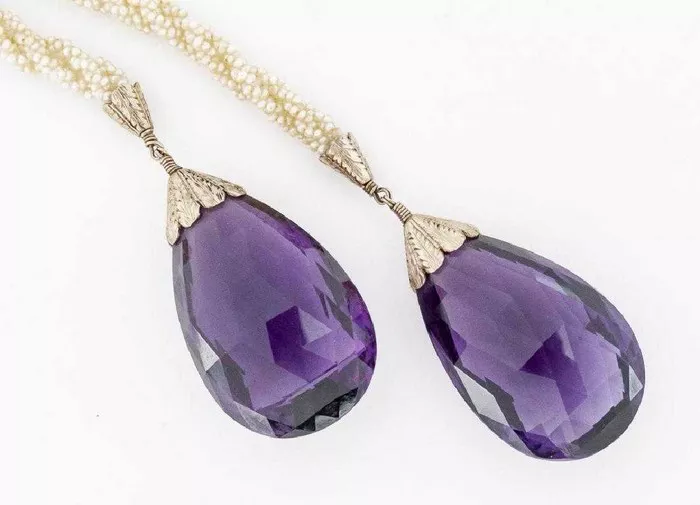Jewelry appraisal is not just about assessing the monetary value of gemstones; it’s also about understanding their unique characteristics, histories, and the myths and legends that surround them. Among the myriad of gemstones, amethyst holds a special place, especially when it comes to the concept of a “spirit crystal.” This article aims to provide a detailed introduction to amethyst, with a focus on distinguishing the “amethyst spirit crystal” from ordinary amethyst.
Overview of Amethyst
Amethyst, derived from the Greek word “amethystos,” meaning “not drunk,” is a variety of quartz that exhibits a beautiful purple hue due to the presence of manganese impurities within its crystalline structure. This gemstone has captivated people for centuries with its range of colors, from light lavender to deep, almost red-tinged purple. Its name is steeped in history, with Greek mythology offering an enchanting tale behind its origin.
According to one version of the myth, Dionysus, the Greek god of wine and revelry, fell in love with a beautiful maiden named Amethystos, who rejected his advances. In a fit of anger and drunkenness, Dionysus sent a tiger to attack her. However, Diana, the goddess of the moon, intervened and turned Amethystos into a crystal-clear quartz statue to save her. Dionysus, realizing his mistake, shed tears of remorse, which stained the statue purple. Another version tells a similar story but with slight variations, such as Dionysus pouring wine over the statue, turning it purple.
In ancient Greece, amethyst was believed to possess the power to prevent intoxication, leading people to wear amethyst jewelry or use amethyst wine goblets during feasts to avoid overindulgence. This belief adds a layer of mystical allure to the gemstone.
What is an Amethyst Spirit Crystal?
The concept of a “spirit crystal” is somewhat nebulous and often used interchangeably with terms like “healing crystal” or “energy crystal” in popular culture. In the context of amethyst, a “spirit crystal” refers to a particularly high-quality or pure specimen that is believed to possess enhanced metaphysical properties.
Spirit crystals are often associated with a stronger, more refined energy field. They are thought to have a more profound impact on the human energy system, promoting physical, emotional, and spiritual well-being. While there is no scientific evidence to support these claims, many people swear by the benefits they experience when wearing or interacting with spirit crystals.
Distinctive Characteristics of an Amethyst Spirit Crystal
Color and Clarity
An amethyst spirit crystal typically exhibits a more vivid and intense purple color than ordinary amethyst. The color should be evenly distributed, with no noticeable color banding or patches.
Clarity is another key factor. A spirit crystal will have fewer inclusions, resulting in a clearer, more transparent appearance. High-clarity amethyst allows more light to pass through, enhancing its shimmer and brilliance.
Cut and Polish
The cut and polish of a gemstone can significantly affect its appearance and perceived value. A well-cut amethyst spirit crystal will have facets that are precisely arranged to maximize light reflection and dispersion, creating a dazzling sparkle.
The polish should be smooth and flawless, with no scratches, abrasions, or polishing marks visible under magnification.
Energy and Vibration
Believers in the metaphysical properties of crystals often claim that spirit crystals emit a stronger, more harmonious vibration. This is a subjective experience, but some people report feeling a noticeable difference when holding or wearing a spirit crystal compared to an ordinary gemstone.
Source and Provenance
The origin of a gemstone can also play a role in its perceived quality and energy. Some mines are known for producing higher-quality amethyst, such as those in Brazil, Uruguay, and Bolivia. A spirit crystal may come from one of these esteemed sources, adding to its desirability.
Comparing Amethyst Spirit Crystals to Ordinary Amethyst
While both types of amethyst share the same basic chemical composition and physical properties, there are several key differences that set spirit crystals apart:
Quality and Rarity:Ordinary amethyst can be found in various qualities, ranging from low to high. Spirit crystals represent the pinnacle of quality, with fewer imperfections and a more refined appearance. They are also rarer, making them more sought-after and valuable.
Metaphysical Properties:As mentioned earlier, spirit crystals are often believed to possess enhanced metaphysical properties. While this is purely anecdotal and not supported by scientific evidence, many people find comfort and solace in wearing or interacting with these gemstones.
Aesthetic Appeal:The aesthetic appeal of a gemstone is subjective, but spirit crystals generally have a more captivating and mesmerizing appearance. Their vivid color, clarity, and cut make them stand out in a crowd, making them ideal for jewelry and decorative purposes.
Price and Value:Due to their rarity and superior quality, amethyst spirit crystals command a higher price than ordinary amethyst. However, it’s important to note that the value of a gemstone is not solely based on its rarity or quality; it also depends on factors such as demand, market trends, and personal preference.
Conclusion
In summary, an amethyst spirit crystal is a high-quality, rare gemstone that is believed to possess enhanced metaphysical properties compared to ordinary amethyst. While there is no scientific evidence to support these claims, many people find comfort and beauty in wearing or interacting with these gemstones. Whether you believe in their metaphysical powers or simply appreciate their aesthetic appeal, amethyst spirit crystals offer a unique and captivating addition to any jewelry collection.
Related topic:


